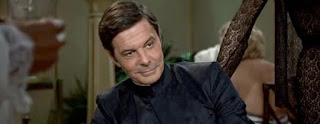Another year, another batch of film society screenings. Same criteria as last year: I pick three films I have not seen before. Unlike last year, one of the films I am (re)viewing this year is not an old classic, but I'll get into it in the next review.
Night of the Demon (AKA Curse of the Demon for its US release) is a British horror film with a great pedigree. It is directed by Jacques Tourneur, the great filmmaker behind several classic horror films of the Forties, including the seminal Cat People (1942), and the classic noir Out of the Past (1947), with Robert Mitchum.
Tourneur's forte was atmosphere and inference, not traditional horror effects. This famous scene from Cat People is the best example of his unique talent. I have heard great things about Night/Curse, so this screening was a no brainer.
Extremely atmospheric. with some excellent jump scares and unsettling imagery, Night of the Demon is a fantastic finale to Tourneur's work in the horror genre, and a terrific start to The Midnight Ramble's series of AFS reviews.
The story is pretty simple. John Holden (Dana Andrews), a paranormal sceptic, arrives in England to do a series of lectures debunking supernatural phenomena. Shortly after arrival, he has to change his plans when he learns that the colleague he would be working with has died under mysterious circumstances. In trying to solve the mystery, he is soon crossing paths with cult leader Professor Karswell (Niall McGinnis), and finds his views challenged by a series of increasingly terrifying incidents...
While the acting by the leads is solid, the real star of the show is MacGinnis as the villainous Professor Karswell.
Slightly effete, and permanently attached to his mother, there is something strangely vulnerable about Karswell that makes him more than your stereotypical Satanist. It is clear that the forces he is unleashing take a great toll, and he is clearly just as frightened of them as his victims.
The movie is filled with memorable set pieces -- the first appearance of the demon; Holden's desperate dash through the woods while an invisible entity leaves burning footprints behind him. Tourneur's control of these sequences is so precise and imaginative, there are moments here that feel totally contemporary. There is an intensity and level of dread here that few films of the same era can achieve.
One thing that separates Night of the Demon from Tourneur's other work, is the wonderfully eccentric vein of humour running through the film. It makes the film feel even more British. At one point there is a seance sequence. Now typically scenes like this one are the kind of hoary cliche that could have stopped the movie dead, yet Tourneur carries it off by focusing on the eccentricity of the medium and his helpers. Singing and chatting away like a family around the radio, they are an offbeat delight that grounds this supernatural hokum in something vaguely approaching reality.
While the film is still extremely scary, the one aspect of the movie that has never worked is the demon itself. The result of a producer's mandate, the demon appears at the beginning and end of the film. It is frankly rubbish.
It is a testament to Tourneur's talents that this bargain basement effect does not ruin the film's credibility. There were collective giggles all round whenever it popped up onscreen.
That aside, Night of the Demon is a terrific slice of classic horror and worth seeing on the big screen.



























